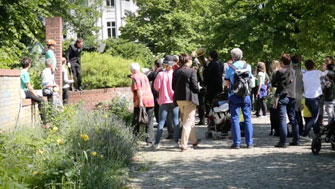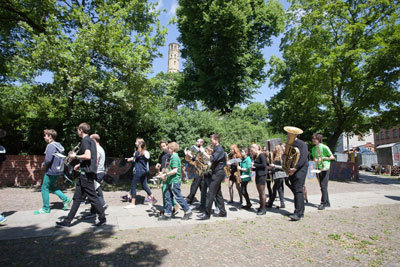daniel ott, wolfgang mitterer, charles ives
PULSE — AUSSEN : stadtmusik
1 June 2014, 3 p.m. — 6 p.m., Wasserturm neighbourhood
The space around the Wasserturm in Prenzlauer Berg — one of the most beautiful urban neighbourhoods in Berlin — will be transformed into a performance space for compositions, sound processions and musical collages with a spatial relevance. For one day, the neighbourhood will be transformed into a stage with many perspectives for a concert composed from a multitude of sounds and music varying in density and volume, in motion and direction. The PULSE — AUSSEN : stadtmusik project gives residents and visitors alike the opportunity of experiencing a completely new atmospheric quality in the neighbourhood. 200 musicians are scheduled to participate: professional musicians, students, amateur ensembles and residents.
The idea of music for public spaces and landscapes reaches a long way back into musical tradition. It is reminiscent of Aeolian harps in parks, organized musical parades and Arseni Avraamov’s Symphony of Sirens.
Charles Ives already had the idea of a spatial music at the end of the 19th century. Contemporary music and sound art enjoy a long tradition in the area around the Wasserturm. As early as August 1990, a widely acclaimed production of the »Music Circus« by and starring John Cage took place at neighbouring Kollwitzplatz. The annual festivals staged by the Kryptonale artists’ group from the beginning of the 1990s to 2005 resonated far beyond the district borders. The resonance of the singuhr — hoergalerie's exhibitions in both water reservoirs since 2007 bears witness to the great openness of the neighbourhood towards innovative artistic projects. PULSE — AUSSEN : stadtmusik carries on this tradition.
3 p.m.
Daniel Ott »1/6 — Wasserturm I-III«
for percussion ensembles and wind instruments (premiere)
Kicking off stadtmusik is a new work by Swiss composer and performer Daniel Ott. »1/6 — Wasserturm I-III« is a composition for percussionists and brass instruments in three parts. In the first part — »wasserturm I — music for woodblocks« — seven percussion groups will be moving through the area surrounding the Wasserturm, coming together at agreed upon times and at fixed places as a group and then separating again: spatial concentrations of percussive sounds and thoroughly structured sound fields alternate with individual percussion accents but also breaks in which the day-to-day »sounds« of the Wasserturmplatz can be heard. In »wasserturm II -- musik für blechinstrumente«, solo trumpeters on the high plateau as well as four brass bands acoustically colour the corners of the park with varying clusters and chords. In the composition, chord structures and rhythmic sequences are on the one hand diverted from the surrounding streets as well as street names and house numbers, yet on the other they are determined by the acoustic peculiarities of the square — resulting in an »on-site« composition. The third part — »wasserturm III — musik für holz & blech« — brings the drummers and brass bands together. As if on an oversized chessboard, groups now move around, sound structures from the first parts are in motion, concentrate and finally congregate on the plateau of the Wasserturmplatz.
4 p.m.
Wolfgang Mitterer »labyrinth 14/1«
Spatial composition for amateur music groups, trumpet quartet, 7 solo drummers, nose flute orchestra, choir and electronics (premiere)
The next performance features the premiere of Wolfgang Mitterer’s »labyrinth 14/1« composition. Mitterer is one of Austria’s most renowned contemporary composers, having enjoyed success both as an organist and jazz musician and as a composer of contemporary and electro-acoustic music. Bringing together both amateurs and professionals, musicians of different styles, classical instruments and electronic sounds in a public space is the starting point of his composition. In »labyrinth 14/1«, six very different groups of musicians play their music as they move around the Wasserturmplatz to a temporal score: four brass orchestras, the Nasenflötenorchester Kreuzberg and a choir. On the hill itself, Mitterer positions a set of loudspeakers radiating indirectly for hexagonal audiotape feeds as well as 7 solo percussionists on the plateau who will be accompanied by 4 solo trumpets from the windows of surrounding houses. Coincidence and composition will mingle, moving and static sounds, electronic and instrumental sounds to a multilayered composition, the ideal listening spot being the high plateau above the water reservoir.
5 p.m.
Charles Ives »Life Puls Prelude«
for 7 percussion ensembles (realisation: Robin Schulkowsky)
It was as early as the end of the 19th century that Charles Ives had the idea of creating spatially structured music, a theme that also occurs in his compositions for concert halls. Wrapping up stadtmusik is »Life Puls Prelude«, a performance conducted by American percussionist Robyn Schulkowsky which serves as a homage to Charles Ives and is taken from the famed American composer’s »Universe Symphony«. Seven percussionist groups — composed of students, professional musicians, music students and amateur percussionists — move about the Wasserturmplatz with their own rhythmical patterns. The compositional foundation of the piece is Ives’ rhythmic pulses, which he termed a »basic unit« and from which all of the individual percussionist groups’ rhythmical patterns are derived. From the centre of the plateau, the groups move slowly along different paths to the borders of the square, continuously offering the listeners new temporal, rhythmic and spatial perspectives on the music.
Participating ensembles:
Chor schreiender Männer Pankow, Jugendsinfonieorchester Marzahn-Hellersdorf, Junges Ensemble Berlin / Blasorchester, Das Original Oberkreuzberger Nasenflötenorchester: Der Grindchor, Schnaftl Ufftschik, Zentralkapelle Berlin
Organized by singuhr e.v.
With the kind support of the Bezirksamt Pankow
Patron: Bürgermeister Matthias Köhne
Supported by: Hauptstadtkulturfonds; Initiative Neue Musik Berlin e.v.; Pro Helvetia, Schweizer Kulturstiftung
»labyrinth 14/1« by Wolfgang Mitterer was commissioned by singuhr — projekte, and financed by the Ernst von Siemens Music Foundation.
media partner: Neue Zeitschrift für Musik

Video: PULSE — AUSSEN : stadtmusik (vimeo)

Album: PULSE — AUSSEN : stadtmusik (photos: D. Lehner)

Album: Daniel Ott »1/6 — Wasserturm I-III« (photos: D. Lehner)

Album: Wolfgang Mitterer »labyrinth 14/1« (photos: D. Lehner)
